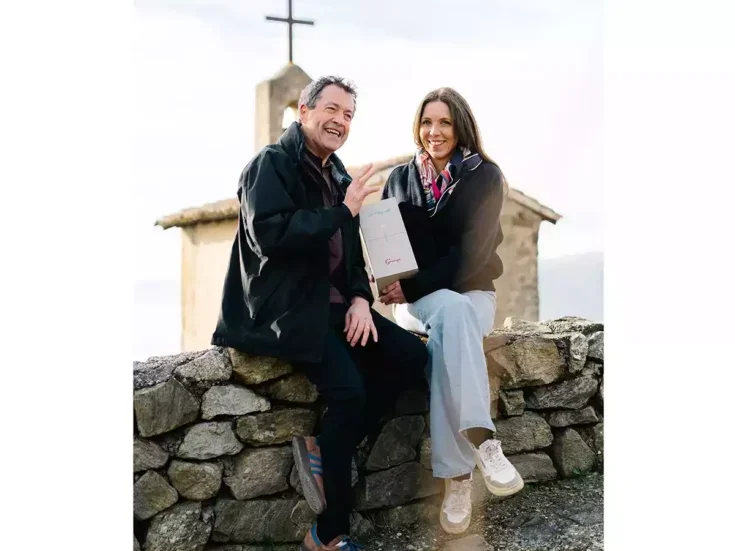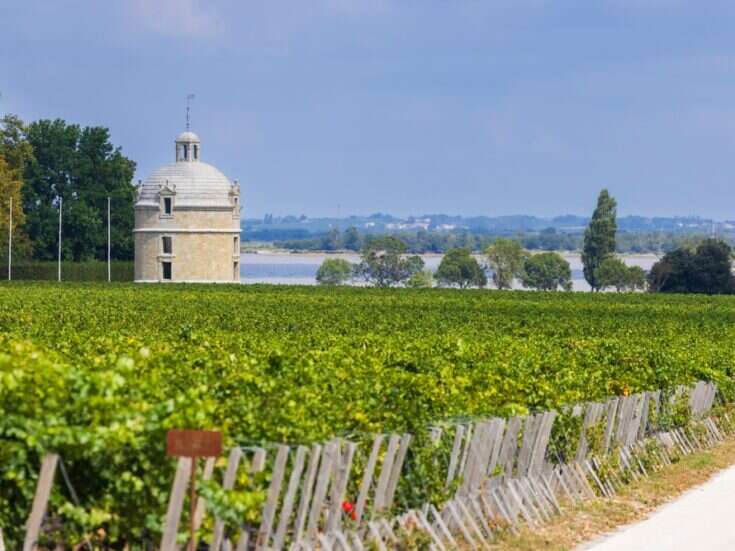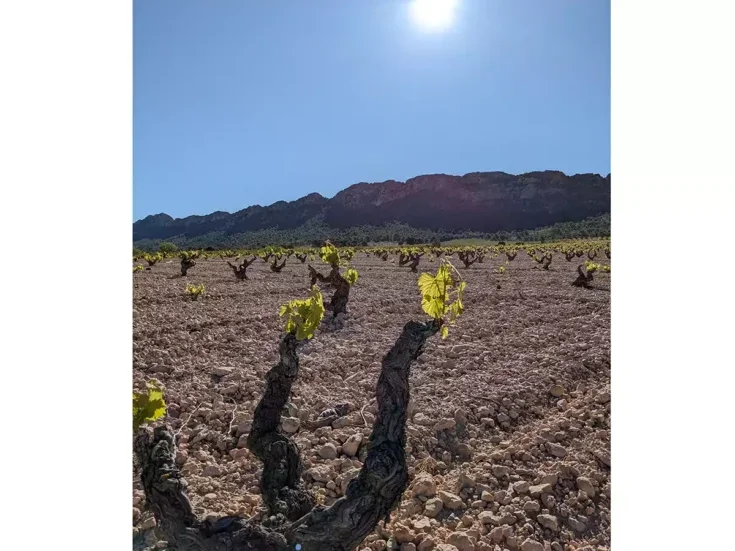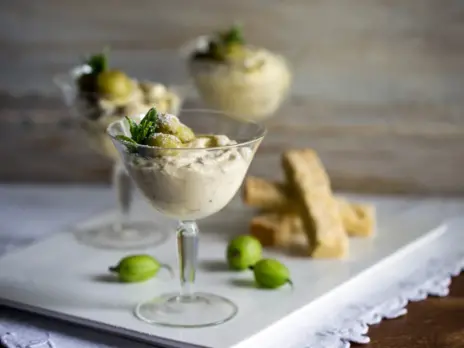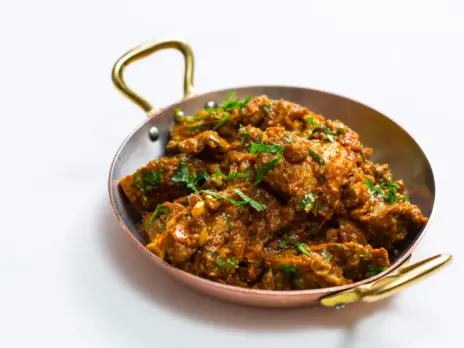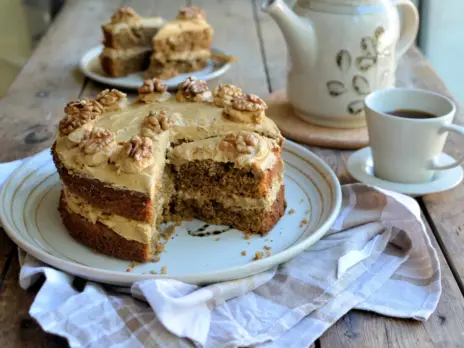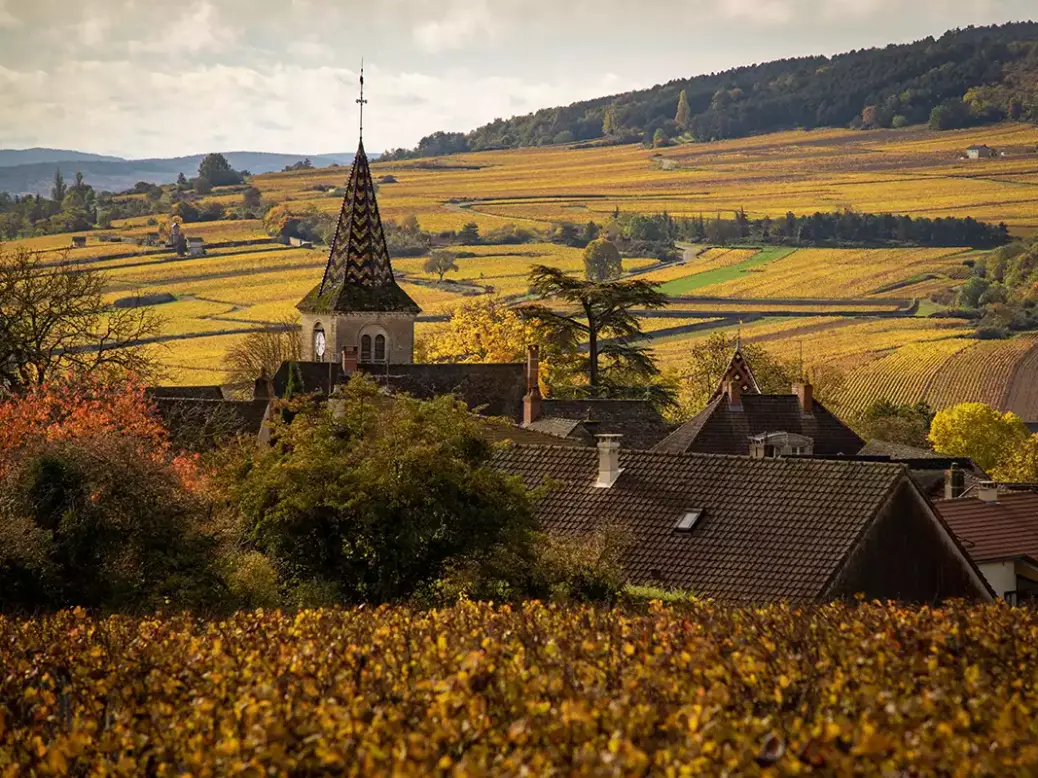
MONTHELIE
DOMAINE CHANGARNIER
Claude Changarnier’s family lived in Monthelie for several generations. I’m told a registration of birth for the first member of the family here dates back to 1610. It seems that the ancestors were lowly manual workers for the church, plowing and such like. But in the early-18th century, his great-grandfather started to purchase vineyards. By 1820, he had accumulated funds to build a rather grand house in Monthelie and move out of the one-bedroom hovel. (This is how Claude presented it!) Grandfather was young when he died, and Claude’s mother started selling off land. His father wanted to find a way of not selling off more. I assume he must have kept things ticking over. He was an engineer and worked in the oil industry. The current generation, Claude, worked at Microsoft and bought out his siblings. To begin with, he ran the domaine while traveling and working for Microsoft, although with the assistance of Fabrice Groussin. Fabrice made the 2023s, but has since moved on, and Claude is looking for a replacement. He has now left Microsoft and is concentrating on the domaine, which extends over 5.5ha (13.5 acres).
“I am not interested in making money. I just want to make the best wines possible,” he told me. They have been certified organic since 2019. He uses a horse-driven plow for two vineyards, including Les Clos which is effectively the walled garden of the house.
There was a green-harvest in early July. Yields for whites were about 60hl/ha. Both whites and reds are sorted, but Claude recalls very little to sort out (no botrytis). Whites are pressed for as long as three hours, but “not over 2 bar.” Fermentation starts in tank and is moved to barrel at a specific gravity of 1.060. Spontaneous fermentation, then about a year in barrel, for which the proportion of new oak ranges from zero, to 40%.
Whole-bunch is up to 50%, depending on the cuvée. The reds are fermented in concrete, and radiators on a cooling system were dunked in to keep the temperature at 13ºC (55ºF) during the hot 2023 harvest. A little remontage and pigeage. “We did almost nothing in 2023.” Total vatting was between 18 and 24 days.
Whites and reds are aged in 350-liter, 400-liter, and 500-liter Stockinger barrels, with a touch of François Fréres. For the whites, 10% is in terra-cotta amphorae. Claude experimeted with reds in terra-cotta, too, to reduce the oak impact, but it didn’t work. Because Claude gave me exact figures for whole-bunch and new oak, I have included them in the notes.
After a year, the wines were moved to vats, and most were due to be bottled by the end of November. The whites are lightly filtered.
Claude said, “It is difficult to compare 2023 with another vintage, as it was so warm. 2022 was perfect. 2023 is closer to 2020 than to 2022—I would think somewhere between 2018 and 2020.”
Bourgogne Les Dressoles
From a vineyard near Meursault. 23% new oak. A ripe and lightly glossy Bourgogne, with a nice freshness and a bite of new oak on the finish, which gives it a lift. Pleasant. 2025–26. 80
Auxey-Duresses Premier Cru Les Duresses
From 0.4ha (1 acre) of vines at the bottom of the climat, planted eight years ago at a density of 12,000/ha. Apparently, it didn’t work well with Chassin oak, being too rich. But from Stockinger barrels, it works a treat and carries the 40% new wood with ease. It is straight and channeled and firm. Quite phenolic, which I like. Chalky tension on the finish. Powers through. Not bad at all. 2025–30. 87
Monthelie
Mainly from Sous le Cellier, a 0.7ha (1.7-acre) parcel, west-facing, on chalky marl, planted in 2000. 10% new oak. Lightly silky from the oak upfront, but it zips into a straight, nicely fresh palate with a tart, lemon character, then on the finish it has a light pithy note. Zesty. 2026–28. 83–84
Monthelie Les Clos
From an enclosed, south-facing parcel planted in 1990, with deep clay and no rocks. Claude doesn’t cut the vines at all—a sort of tressage. They create a bridge between the vines, because they are so vigorous, and apparently this works better than topping. Rich, with ripe apricot fruit, and rounded, with a creamy quality. I like the fact that the village Monthélie wines are so different. I marginally prefer the previous cuvée, but both are good. 2026–28. 83–84
Meursault Les Malpoiriers
From 65-year-old vines on the Volnay side—not in the best place. “My grandfather has some premier cru Charmes,” Claude said wistfully. 24% new oak. 1,500 bottles. A ripe and juicy Meursault. Full and generous. Slightly tropical fruit. It needs the new oak to lift the finish and accentuate some freshness. 2026–30. 86
Red
Monthelie
Some of the fruit for this blend comes from La Combe Danay, a lieu-dit that is relatively cool, in the combe, and frost-prone; one part faces west, and one east, and they have very different soil types. So, it is clearly not an easy place to manage. Some fruit also comes from Les Sous Courts, which is south-facing and much easier. The vines average 40 years old. 8% new oak. Spicy red fruit, rich and a touch jammy, yet quite piquant and stemmy—from the 25% whole-bunch, I assume—which gives the spicy, herbal twang to the finish, which works well. 2026–29. 82–83
Monthelie Pierrefitte
From a southeast-facing parcel next to the forest, planted in 1966 on chalky marl. 28% whole-bunch and 15% new oak. Spicy on the attack. A tart snappy note, and the whole-bunch aromas on the finish are on the greener side of crunchy, so I prefer the Monthelie village blend. 2026–28. 82
Monthelie Premier Cru Champs Fulliot
From a south-facing parcel planted in 1979, with only 40–50 cm (16–20 inches) of topsoil over the mother-rock. 50% whole-bunch and 20% new oak. A pure, red-fruit aroma. A cool sweep into the palate on fine-textured tannins, and this has appealing austerity. Good tension. Slight severity. The finish is powdered chalk. Very good indeed. My favorite red here. 2026–32. 88
Monthelie Premier Cru Les Clous
Claude has two parcels here, running form the top to the bottom of the fairly steep, east-facing slope, slope; the soil is a chalky marl lower down and more calcareous higher up. 40-year-old vines. “We have worked a lot on this terroir,” Claude explained. “The soil was quite poor, and the move to organic has helped. It is the one that has improved the most over the past ten years.” 25% whole-bunch and 13% new oak. 4,000 bottles. Straight, showing some tension. Slightly strict. Here I like the herbal note. Energetic, having nip and snap. 2026–30. 87
Monthelie Premier Cru Meix Bataille
From a south-facing parcel planted in 1982 on clay-rich soil. “It is our Pommard in Monthelie.” 25% whole-bunch and 35% new oak. A black-forest, wilder feel, with a dark, smoky note. Full and sweetly earthy, with a graphite finish. Slightly grunty. It has personality. 2026–30. 87
Pommard Les Vignots
From two southwest-facing parcels, separated by one owned by a producer who is not working organically, unfortunately. Claude says it is very warm here, especially in the higher parcel close to the top of the slope, where there is a lot of sun, no cool draught, and a lot of small white stones. 40% whole-bunch and 5% new oak. Sweet fruit on the nose and the attack. A seductive, ripe palate, with quite soft tannins, needing the whole-bunch to give it freshness. Works well. Inviting. 2026–32. 88
Pommard Vaumuriens
One parcel here is in the Haut section, facing northeast and very vigorous, so this they need to green-harvest, while another parcel is in the Bas section, facing west. 25% whole-bunch and no new oak. Straight, intense, black fruit, tight and more biting. It has a much grippier structure than the easy-going Vignots. 2026–32. 88
AUXEY-DURESSES
DOMAINE THOMAS BATTAULT
Thomas Battault is one of several young producers in Auxey-Duresses making some rather good wine. And he did a really good job in 2023. I perhaps preferred the whites, but there is an engaging, fresh, and vibrant Beaune premier cru red, Les Arvaux, which is quite a feat this vintage. The whites are more savory than fruity, with attractive, pithy, phenolic notes.
Bourgogne
12.5%. ABV. A light citrus aroma to a soft, gentle, and rather creamy palate, with some attractive leesy notes. It’s very pleasant and nicely balanced. I like the hint of marzipan. 2025–27. 83–84
Auxey-Duresses
A pithy, biting, and savory Auxey-Duresses. On the bitter-almond side of things. Almost quite crunchy. Not green, but keen and lean, with apple pip on the finish, although it is 13% ABV. Plenty of energy here. I tasted the finished article in bottle. Among the best I tried. 2025–28. 85
Meursault
Lightly oaky notes to this plump and generous Meursault. Classic, fuller bodied, rounded style, but not overly rich. In fact, it is quite airy. It’s 13% ABV and nicely balanced. I like the slightly phenolic bite to the finish. There is white peach at the front of the palate then a savory, almond profile. A very appealing village wine. 86
Red
Auxey-Duresses
Ripe, baked-cherry aroma, and soft, ripe, red-plum fruit upfront, but then it snaps into something crisper and more interesting. I like the crunch to the tannins. There may be a touch of bitterness to finish, but attractively so. There is bite. 2025–28. 82–83
Beaune Premier Cru Les Arvaux
The aroma is bright and lively, with red fruit, then the palate is energetic and crunchy. I find this so inviting, with its red-cherry, fruity palate and cherry-stone snap. It has a zesty quality not easy to achieve in Beaune. Just a slight sense of the warm harvest in the background. 13% ABV. This is a good example of what could be achieved in Beaune in 2023. Late-2025–30+. 89
ALAIN ET VINCENT CREUSEFOND
There was no green-harvest here. Picking started on September 5 for the whites and the 15th for the reds. Harvesting is by machine, so both reds and whites are destemmed. Light pigeage for the reds for ten days and daily remontage for 14. The whites receive bâtonnage twice a month before malolactic and once a month afterwards until June. The whites were bottled just before the following harvest and the reds just after. Alain Creusefond observes, “It’s difficult to compare 2023 with other years because the temperature was higher during the growth cycle, which gives wines of more color, more complex minerality, and more intense flavors. Ten years ago, they were not the same—the change in the climate gives different whites wines, with more density and intensity and lighter acidity. They’re so lovely young that many people drink them too quickly.”
Vincent has been working alongside Alain for some years now. The texture of the reds is softer in 2023, and the expression more aromatic and fruit-driven.
White
Auxey-Duresses
An attractive, peachy palate, and at 13% ABV, nicely rounded and well-balanced, with some freshness on the finish. It’s pleasing. 2024–25. 83
Auxey-Duresses Premier Cru
From En Reugne, although this is not declared on the label. More concentration, creaminess, and richness. Ripe apricot fruit, with juicy succulence, a note of oak bringing freshness to the finish. 2025–27. 85
Red
Auxey-Duresses
Sweet, ripe raspberry fruit aroma and a soft, red-fruit palate. Gently rounded. Light and supple tannins. This is very approachable, with just enough acidity to give a light crunch to the finish, combining with the aromatics reminiscent of a hot summer. 2025–28. 83
Auxey-Duresses Premier Cru Climat du Val
Super-ripe, with black-cherry fruit; succulent mid-palate and light tannin, a lick of licorice and an aromatic anise note to finish. 2025–30. 85
DOMAINE MICHEL PRUNIER ET FILLE
This is certainly among the best domaines in Auxey-Duresses. The whites are citrusy, with fresh acidity, but always nicely rounded and succulent. Estelle Prunier likes to chaptalize the white a little to balance the typically fresh acidity in Auxey. The regional wine is 13% ABV, the rest of the range 13.5%. “We prefer to have the same degrees each year, at 13.5%,” Estelle explained. The reds are fruity, with soft tannins, pepped up with the freshness of whole-bunch.
Estelle recalled the vintage thus: “The crop was large. The heatwave was good to ripen the fruit, as we had a good quantity, so we were happy.” Harvest started on September 7 and finished on the 20th.
The whites were not acidified in 2023 (TA levels were 3.46–3.80 and pH levels 3.30 to 3.40), but they were chaptalized a little. Whites are whole-bunch pressed. Estelle likes a lot of lees, “as we think the lees give a rounder palate, and we do bâtonnage until Christmas time.” The whites are bottled before the end of the year.
“The whites are like 2018—also a warm vintage and a nice vintage for whites. For the style and for the season. I feel the vines are now more regularly stressed. 2018 was the first vintage we had stress, but then we had it again in 2019, 2020, and 2022. 2018 was the beginning of this cycle, and we see greater consequences now.”
As for the reds: “We didn’t do a green-harvest for the Bourgogne—the yield is never high because the soil is not very rich. But it was necessary for the other reds.” Almost all the reds are hand-harvested. Just the 2ha (5-acre) Hautes-Côtes vineyard is harvested by machine.
“We didn’t need to throw away much Pinot Noir fruit—there was no botrytis, as it was warm before harvest. We just had a little acid rot. So, we checked the quality. The health was good. The skins were not too thick and quite normal, so the color came quickly. Yields for the reds averaged 54hl/ha for the premiers crus and 56hl/ha for the village wines.
“You lose the acidity in the press with whole-bunch. We press up to two bar—which is necessary with the whole-bunch—but we can select the wine. We keep the press wine separate but usually we can blend it in, which we did for the 2023 premiers crus.”
Estelle uses claies or wooden slats in a marc immergé approach—a submerged cap about one third of the way down the tank—and only remontage. “I think this is why we do not have much tannins. As we have a lot of bunches, we have to be careful. It was much more common in the past.” After pressing off, the fermentation finishes in vat. “The difference with a proper carbonic is that it is not under gas.”
Her red wines from Beaune and Volnay are light-bodied and charming. “The reds I would also compare to 2018. Not a powerful structure. Quite fine.”
Bourgogne Chardonnay
A blend of fruit from a limestone Hautes-Côtes vineyard and a parcel below Meursault, which gives richness. Eleven months in barrel, with no new oak. 13% ABV. Attractive, light, lemon aroma, to a lightly rounded palate, which has a little lemon pithiness and a chalky minerality to the finish. 2025–27. 83
Auxey-Duresses
A blend from Les Closeaux, which is in a little combe, and Les Hautes, which is more west-facing. 11 months in barrel and 10% new oak, the rest 3 or 4 years old. White peach and nuts on the nose, then on the palate this has rich and ripe citrus notes, a lightly creamy texture, and vibrant, fresh-grapefruit acidity. 2025–28. 85
Auxey-Duresses Vieilles Vignes
The vines for this are 86 years old and are planted across the slope. “The old vines can support more new oak—30%,” said Estelle. “We use several coopers.” The parcel is La Canée, where the two roads divide when you take the road up the hill, and the soil is a mix of limestone and clay. They do not declare the lieu-dit on the label. Notes of marzipan on the nose. Nicely juicy and creamy, with a touch of just-ripe apricot alongside the ripe citrus notes. Rather yummy hazelnuts on the finish. All nicely balanced. 2026–30. 86
Meursault Les Clous
From a parcel under the hut in the vineyard. A step up in elegance, more delicate and pure. You taste the limestone here. It is lightly silky, with white-peach fruit and a thread of minerality and light bitter notes, which are attractive. “I am happy to keep that,” Estelle said. 2025–30. 87
Red
Bourgogne Pinot Noir
From a 50-year-old vineyard, planted just after Michel’s wedding, on the Meursault side of the village. Harvested by machine and destemmed. This is soft, juicy, and fruit-driven, with soft summer fruit and an aromatic finish. 2025–27. 82–83
Auxey-Duresses
A blend from several parcels. 50% destemmed. Supple, ripe fruit. Juicy and succulent. The tannins have a light structure, and it has a twang from the whole-bunch on the finish. Very accessible and easy-going, but good quality of tannins. Very nice texture. 2025–28. 85
Auxey-Duresses Premier Cru
A blend from Climat du Val (roughly 50%), south-facing on limestone; Les Grands Champs (25%), flat, also south-facing; and Bas des Duresses, looking east toward Monthelie, which has more clay. Blended as grapes. “This is easier, so I have the volume in the tank.” 50% whole bunch. Blackberry fruit. Full and juicy, soft and generous, sweet fruit, light tannins, and at the end, a pretty herbal note of mint and thyme. Late-2025–29. 86–87
Auxey-Duresses Premier Cru Clos du Val
From a 1ha (2.47-acre) section, of which the domaine owns half, above the little pergola and by the track. 50% whole-bunch: “When we have a warm vintage, we use 50%. Even in 2024, we kept a little, as we don’t want to change the aromatics too much.” 25% new oak. This is definitely riper, with black-cherry fruit, licorice, and spice. A slightly grippy palate, with the stemmy freshness of the whole-bunch. But the tannins are fine-grained and there is a herbal freshness—cocoa powder and mint. Late-2025–28. 86–87
Beaune Premier Cru Sizies
From a relatively young parcel planted in 2003, in a fairly flat section of the vineyard, but where the clay is quite light, so it still drains quite well. 50% whole-bunch. This has spicy white pepper, star anise, and strawberry fruits. It moves into an exotic spectrum. Light, soft tannins, but looser and more aromatic, and the whole-bunch picks it up. An attractive Beaune, since it is not too sweet on the finish, which some can be in 2023. 2026–30. 88
Pommard Les Vignots
50% whole-bunch and 30% new oak. I prefer Estelle’s Pommard this year, as the tannins are soft and the fruit is ripe and dark and slightly spicy. The whole-bunch gives herbal lift. Instead of the usual 100%, she he has used only 50%, and I feel this is better. An accessible Pommard. Estelle punches down and does remontage on this cuvée—the only wine in the range for which she uses a more classic approach. “I want to have more tannin, as it is Pommard, but I am still careful with the pigeage, so it is not hard.” Late-2025–29. 87
Volnay Premier Cru Les Cailleret
From the Dessus section. Very ripe, red-fruit aromatics and it splashes into a succulent and juicy mid-palate. The tannins are soft and delicate. It is ripe but not heavy, and the whole-bunch gives lift and freshness. Charming. 2026–32. 90
DOMAINE JEAN ET GILLES LAFOUGE
I tasted with Maxime Lafouge, who is working with Gilles. The domaine is concentrated on Auxey-Duresses, where they have 10ha (25 acres). They harvested from September 6 for ten days, picking the reds in the morning. The domaine has a modern winery below the village, where there plenty of space for cooling: “Very important, as it was so hot,” recalled Maxime.
“For the whites, we keep more and more lees, as long as we’re sure they’re healthy—there was not too much oidium in 2023. When the fruit is prefect, we settle the juice for 18 hours, but in 2023 it was more like one day of settling. A very long fermentation because of the level of sugar—it took five or six months.” Spontaneous fermentation and malolactic here. The Auxey-Duresses whites were moved into tank before the following harvest and were to be bottled in February 2025.
“For the reds, we had high yields, even though we did a green-harvest—the work in the vineyard early in the season was not enough. It has never happened before. The quality was not perfect for the reds, as we had some botrytis. No stems this vintage—we were waiting for perfect phenolic maturity, which is really important for Auxey-Duresses. It was important to harvest into boxes and then to make a strict selection. But after that, we could do some extraction, starting with a cool maceration. The fruit in the vat was nice and it smelled good, so we could extract more at the beginning, when there was not too much alcohol. Just a small immersion. The fermentation started very quickly, after five or six days—no remontage at that stage, which would have made it go even more quickly, just a little afterwards to extend the vatting to 20 days before pressing. We kept the temperature no higher than 28ºC [82ºF].”
“We have some tension and energy in the 2023 whites to balance the ripeness—beautiful quality. I am sure it will be good to wait and enjoy them after ten years—not like 2020, when it was too hot. We were anxious about the red vintage initially, but when we pressed, we were so happy with the quality, and as the wines evolve, they now look more like the 2022s—less gourmand and slightly straighter, with a little more tannin. We are very pleased to have made full-bodied wines from such a large crop of grapes, which was only possible thanks to the strict selection and sorting.”
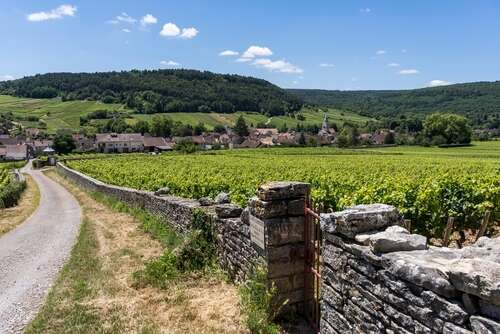
Aligoté
From 65- to 70-year-old vines on a northwest-facing slope in front of the winery. I like the white-citrus pithiness on this light, straight, and pure palate. Stainless-steel tanks only. Already bottled before the following harvest. Attractive Aligoté. 2025–28. 82
Auxey-Duresses Boutonnières
“The soil is only 30–40cm [12–16 inches] deep here, as the slope rises quite steeply and there is a lot of rock—you can still see some of the big stones that were removed years ago.” Juicy and ripe, generous, a touch tropical, but on the finish it is pithy, with a light, cool salinity. “Boutonnières has that saltiness to the finish.” 2025–32. 86
Auxey-Duresses Les Hautes
A blend from several very diverse parcels, across a total 2ha (5 acres). This is ripe and creamy up-front, then more mineral on the finish. Sweet, shiny minerals. More gloss, and the finish is longer here. Maybe the richest of the three Auxey village wines: a mini-Meursault. 2025–32. 87
Auxey-Duresses Macabrée
From a 0.5ha (1.2-acre) parcel between the two tracks going up from Auxey-Duresses toward Meursault, under the line of hedgerow and trees. Citrus, white fruit, and a touch of white peach. Elegant and pure, more open and rounded than the Boutonnières, with silky florals on the finish. Less mineral and more floral. 2025–32. 86
Auxey-Duresses Premier Cru Les Duresses dit La Parapelle
From young Chardonnay vines planted in 2015, in a parcel so steep that it is impossible to use a tractor here. Super-citrus and vibrant, light and very straight, with mineral cut. There is good tension and energy and pithy citrus on the finish. Not as long as the Hautes yet, but from young vines. “For us, it is very interesting to have a white on this side of the village as we didn’t have one before,” said Maxime. “The other side of the hill is more like Meursault, but this, I think, is more like Puligny.” 2026–32. 87–88
Red
Auxey-Duresses
This is from six different lieux-dits. Juicy and fruity. Soft tannins and ripe red fruits, with a crisp snap to finish. 83
Auxey-Duresses Premier Cru La Chapelle
From a small, southeast-facing vineyard, between Les Bréterins and Reugne. There are only two owners—it was owned wholly by the domaine, but Maxime’s grandfather divided it on his daughter’s marriage with Henri Latour. “A beautiful plot, with 85-year-old vines, and this helps.” This is juicy and much fresher than the Climat du Val. There is a light crunch to the tannins, which gives a nice freshness. Quite finely textured tannins and a light piquancy to the finish. Late-2025–28. 86–87
Auxey-Duresses Premier Cru Climat du Val
“There is a big impact from the sun here at the end of the day. We have to focus on making the wines more digestible, to try and add some freshness. It is always spicy.” Super-ripe aromatics of red summer fruits, quite exotic. Soft tannins and, yes, spicy. Late-2025–28. 86
Auxey-Duresses Premier Cru Les Duresses
From a southeast-facing parcel. This is certainly the best of the three red Auxey premiers crus. The tannins are suaver, there is more depth, and there is a slightly licorice finish. It is supple and rich. 2027–35. 88
MAISON OLIVIER LEFLAIVE
Franck Grux handed over to Solène Panigai for the 2023 vintage, but it is really with the ’24 vintage that Solène has made changes. Previously at the BIVB, she worked on the technical side collaborating with many wineries in Burgundy on projects linked with climate change and preserving acidity in the wine. No time to discuss it this year, but next time The house has lost some of its Rully premier cru suppliers, and the wines have been replaced with two Montagny premier crus.
Bourgogne Blanc Les Sétilles
From more than six parcels and 40 suppliers, although some of the fruit is domaine. Most of the parcels are around Chassagne, Puligny, and Meursault: “We want to find the identity of these village in the wine.” It also includes some Hautes-Côtes from Echevronne and some Mâcon. Everything is made separately, some in tank and 70% is fermented in barrels. Racked from May onwards and blended. 100,000 bottles. What a lot of work must go into this cuvée. A peachy fruit aroma, with a hint of warming oak. Rounded, juicy, and generous wine, underscored with lemony freshness. 2025–27. 83–84
Bourgogne Blanc Oncle Vincent
Some of the fruit is from a domaine vineyard under the Château de Puligny, but some is from four other parcels, all in the Puligny area and all barrel-fermented. 2,000 cases. A fresh, upright, citrus aroma. Much straighter than the Sétilles, with light minerality and a bright finish. A slight nervosity, which I like. 2025–28. 85
St-Romain
From two parcels—En Chevrot and Pollange. Slightly creamy, lemon curd on the nose and front-palate, but it tightens up and there is freshness to the finish. Showing just enough energy. 2025–28. 85–86
Meursault-Blagny Sous le Dos d’Ane
From a parcel replanted in 1995. A cool and stony aroma, chic, then a neat and tight attack. Super-ripe but savory and sappy to finish, with lovely length. Straight, high-toned, and direct. It has vibration. 2026–32. 93
Montagny Premier Cru Les Vignes Sur Le Cloux
This has the same orientation as Garchères, the other new Montagny premier cru in the range. From a mix of younger and older vines. Some of the fruit is vinified in foudres of 22hl. By comparison with the Garchères, this is straighter and more floral, with a nice line of minerality and freshness, and it is also a little longer than Garchères, even though the latter is entirely from older vines. 2027–30. 86–87
Pernand-Vergelesses Premier Cru Sous Frétille
Bright, lemon-sherbet aroma, but with a savory cut to the palate, which is rather powerful. Neatly edged—this shows some grunt to finish. Good terroir expression. 2026–32+. 90–91
Puligny-Montrachet
Fruit from several different lieux-dits made this fresh and neatly edged wine, which has plenty of energy. Clipped and straight. A vivacious and quartz-mineral finish. 2025–28. 88
Puligny-Montrachet Enseignières
Partially from domaine fruit A richer aroma. Deep and dark strike. This is grippy and rich. Quite powerful and dense. Burnished-steel minerals. Burly Puligny. 2026–30. 89
Puligny-Montrachet Premier Cru Les Folatières
Domaine fruit, from a parcel in the middle of the climat, for this elegant Folatières, which has a fluid and mineral, floaty feel. Shimmies across the palate to a sparkling finish. I really like it. 2026–32. 93–94
Red
Pommard
A blend from Chanlins, a village plot just above the premiers crus, and three parcels from below. An attractive floral aroma, with red fruit. Slips into the palate on silky tannins, supple and gentle, undercut with nice freshness. Rather a pretty, red-fruit, village Pommard, which is lightly aromatic on the finish. Good job. 2026–32. 87–88
Santenay
A blend from Les Prarons Dessous, which is a deep soil, and Les Crais on the Maranges side, which is more limestone-based. Red-cherry fruit aroma and a splashing palate. Firm-ish tannins and quite piquant and lively on the finish. Attractive. 2025–30. 86
2023 Burgundy: Abundant variability
2023 Burgundy: A guide to the villages and vineyards
2023 Burgundy: Chablis with a sunny disposition
2023 Burgundy: Chablis tasting notes
2023 Burgundy tasting notes: Côte de Nuits—Marsannay and Fixin
2023 Burgundy tasting notes: Côte de Nuits—Gevrey-Chambertin
2023 Burgundy tasting notes: Côte de Nuits—Morey-St-Denis
2023 Burgundy tasting notes: Côte de Nuits—Nuits-St-Georges
2023 Burgundy tasting notes: Côte de Beaune—Beaune
2023 Burgundy tasting notes: Côte de Beaune—Pommard
2023 Burgundy tasting notes: Côte de Beaune—Volnay
2023 Burgundy tasting notes: Côte de Beaune—Meursault

